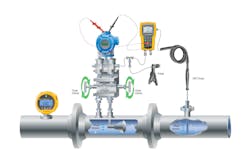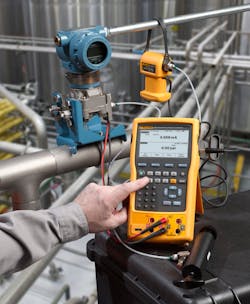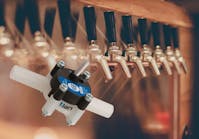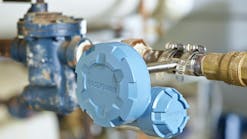Best practices when calibrating gas custody transfers
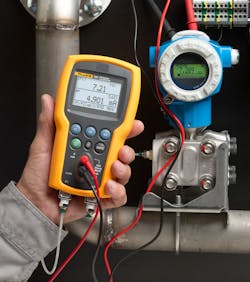
In many oil and gas operations, flow computers are used to take more precise measurements and get exact flow rates for liquids or gases running through a pipeline. Gas custody transfer flow computers that calculate flow by measuring the differential pressure across a flow restriction, such as an orifice plate or other differential pressure flow device, require special calibration to perform at optimum accuracy. In custody transfer applications where the buying and selling of commodities like natural gas is involved, calibration checks are performed frequently to ensure accuracy.
Flow computers need to take multiple measurements to calculate the flow. In a normal application, three measurements are made:
- Volumetric flow or the difference in pressure across the orifice plate
- Static (line) pressure in a pipeline
- Temperature of the gas
A calculation is performed using this data to determine the actual mass of the oil or gas flowing through the pipeline.
Why does calibration matter?
When working with oil and gas, accuracy in custody transfer can make a big difference for financial reasons. Because such high volumes of liquid are going through pipelines, even small errors can lead to significant issues down the line or large financial impacts. Ensuring the amount of liquid flowing where you want it to means that customers are getting what they paid for, you are getting paid for what is transferred, and contracts or legal specifications are met.
Given how important the accuracy is, multiple transfer meters are often used in conjunction with meter provers to ensure all measurements agree with one another at particular locations. If something is off, calibration records, such as those listed below, can be helpful in dispelling or disputing any issues.
- The steps you took to complete the calibration
- How often is the calibration done
- What procedure was used
This kind of information can play a part in helping to figure out who is right, who is wrong, and who owes whom in these situations.
Best practices
Given the financial implications included in custody transfer, the tolerances are usually tight — whether defined by the industry, a governing body or contracts. Even with the most advanced technology and the most careful technicians, operational uncertainty plays a part in the process. Many variables can occur during operation, many of which are process-related metering errors in the field. Disturbances to the regular process such as blockages, pulses, issues with a valve or even contaminants are all problems you have no control over but could cause a significant impact on the measurements and accuracy.
So, what are the best practices to keep in mind while working through a custody transfer and why?
Calibrate your tools regularly
Calibrating your instruments can help ensure accuracy and traceability if any issues do come up. But, beyond the financial reasons, it is important to calibrate your instruments regularly, or at least as often as the manufacturer recommends. Instrument accuracy can drift over time and an incorrect measurement may not be as obvious because of this. Recalibrating on a regular basis helps to mitigate the risk an inaccurate measurement can cause.
It can be a tedious process to calibrate all of your instruments, though. The steps can involve taking a process instrument out of operation and sending it off to a calibration lab for a period of time. Dealing with this can involve downtime or having to use a spare instrument. This process can also involve using contractors or planning for field calibrations, but being ahead of any issues and having complete confidence in the accuracy of your tools can help more in the long run.
Preventive maintenance
As with any process that involves tools and equipment, staying on top of repairs can keep things running smoothly. Unplanned downtime or asset breakdown can cause larger issues across your process. Along with calibrating your tools, checking them and any assets regularly to maintain them can help catch many issues before they become large and costly. These regular checks can develop a baseline for what is considered normal with each asset, raising red flags early when anything is out of the ordinary. Developing a routine and documenting the measurements can help keep your process on track.
Double check your measurements
With potential disturbances that can impact process conditions, it has become a common best practice for many to use two different pressure transmitters during custody transfer. These transmitters are set up in series so the second transmitter can offer a double check of measurements coming from the primary transmitter.
If you do not have two transmitters in series, verifying that your instruments are working properly before and after your completed measurements is another simple way to ensure your measurements are on track.
Document measurements carefully
Documenting measurements can be tricky, especially if you need to juggle a pen and paper while taking them. Instead, use tools that offer saved measurements or are enabled to work with an app or cloud-based platform. These backup measurement options can help save the information not only for yourself, but for others to check without being on site or in the field.
Consider other ways to ensure precise measurements
As technicians routinely calibrate all of the pressure and temperature transmitters involved in the flow of oil and gas, as well as the pressure in the pipelines or other related equipment, there is often a focus on accuracy based on ideal conditions. But, as this article has mentioned, conditions are not always ideal for a transmitter’s performance. Controlling some of the other factors that affect system accuracy can help in those mitigating circumstances. Consider:
- The alignment of the pipes: Properly align the pipes leading to and away from the flow meter.
- Header sizing: A typical custody transfer system has multiple transmitters installed across a single header. Proper sizing can avoid inaccurate results.
- Temperature sensor locations: Place sensors at locations that follow regulations.
- Component ratings: Choose flow system components that are rated to the desired accuracy.
Bob Crepps is a product specialist with Fluke Corporation focusing on the process calibration tools group. He has more than 30 years of experience providing technical support and training in the electronics industry.

Bob Crepps | Product specialist with Fluke Corporation
Bob Crepps is a product specialist with Fluke Corporation focusing on the process calibration tools group. With more than 30 years of experience providing technical support and training in the electronics industry, Crepps has been offering his expertise to Fluke Process Tools for 10 years.
